Looking back on your year of golf, did you have any rules “incidents” that you’re still dwelling on? Hopefully not, but some of the best golfers out there probably can’t say the same. There were dozens of issues in major and minor tournaments in 2023 that left hard feelings and some uncomfortable, memory-sticking moments.
Here now, then, is our annual collection of the biggest rules issues of the past year. Suffice it to say, they’re all strong reminders that even the golfers who play the most (and do it for a living) are not impervious to rules gaffes.
The following are in chronological order.
Patrick Reed’s tree trouble in Dubai
Playing the 17th hole at the Emirates Club during the third round of the Hero Dubai Desert Classic last January, Patrick Reed said his tee shot got stuck high up in a palm tree. Rules official Kevin Feeney had to use binoculars to help confirm that the ball in the tree was Reed’s (the former Masters champ said he marks his ball with an arrow, and that arrow was visible). Once that decision was made, Reed was able to take an unplayable lie under Rule 19.2 and drop under the tree while taking a one-stroke penalty. Had Feeney and Reed not been able to positively identify the ball, Reed would have had to return to the teeing area and treat his original ball as lost. Reed wound up making a bogey on the par-4 hole and ultimately finished second in the tournament, one stroke back of Rory McIlroy.
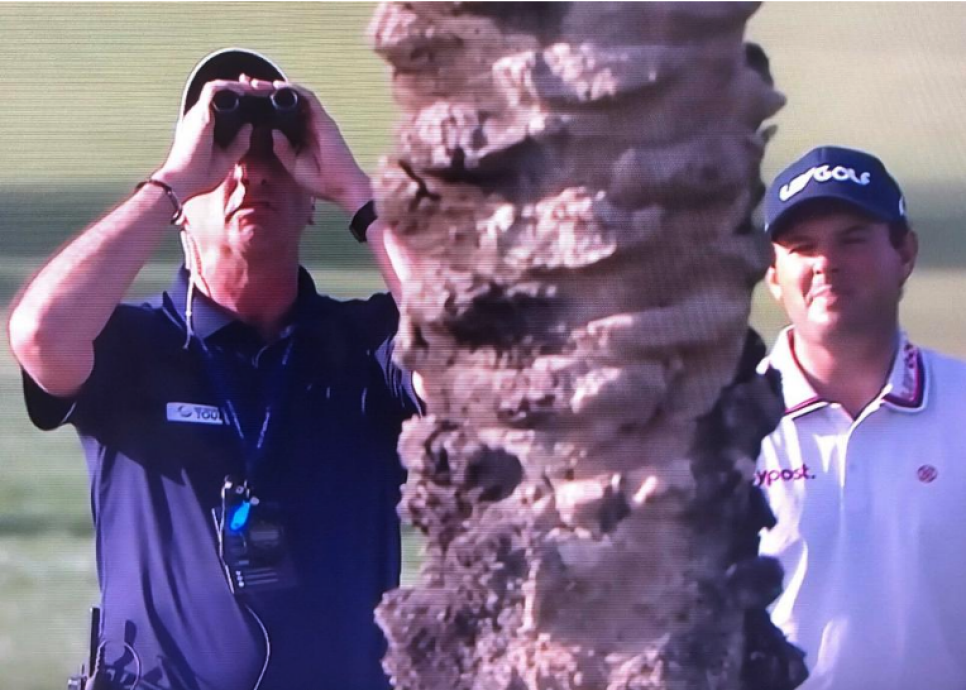
• • •
Collin Morikawa’s ball moves on a slick Augusta green
During the first round of the Masters in April, Collin Morikawa was standing over a long birdie putt when he backed off. After speaking with his playing partners, Morikawa was seen placing his golf ball a few inches in front of his ball marker and then moving the coin toward the ball. Did Morikawa get caught moving his ball closer to the cup? Hardly. First, it was a 37-foot putt, so a few inches wouldn’t have given him much of an advantage. But more to the point, Morikawa let his playing partners know that his ball had moved, and he was going to return it to its original spot before putting.
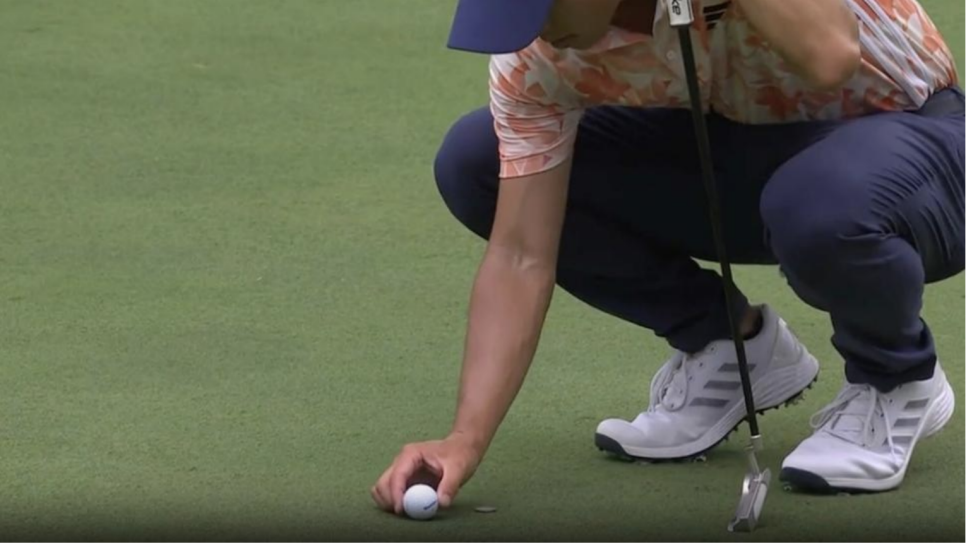
Rule 13.1d says if a ball on a putting green moves accidentally (or the ball marker moves for that matter), you can replace it without penalty. This includes hitting the ball accidentally with your putter as you sole it or make a practice stroke. If the ball moved before Morikawa had marked it, he would have had to play it from its new location.
• • •
Brooks Koepka’s caddie raises some eyebrows at the Masters
Also during the first round of this year’s Masters, Brooks Koepka’s caddie, Ricky Elliott, appeared to mouth the word “five” that got people wondering if had signaled to Gary Woodland’s team that Koepka had hit a 5-iron into the 15th hole. Rule 10.2 covers situations where players ask for or are given advice by anyone other than their caddie, and it was brought to tournament officials’ attention that this might be in direct violation of that rule.
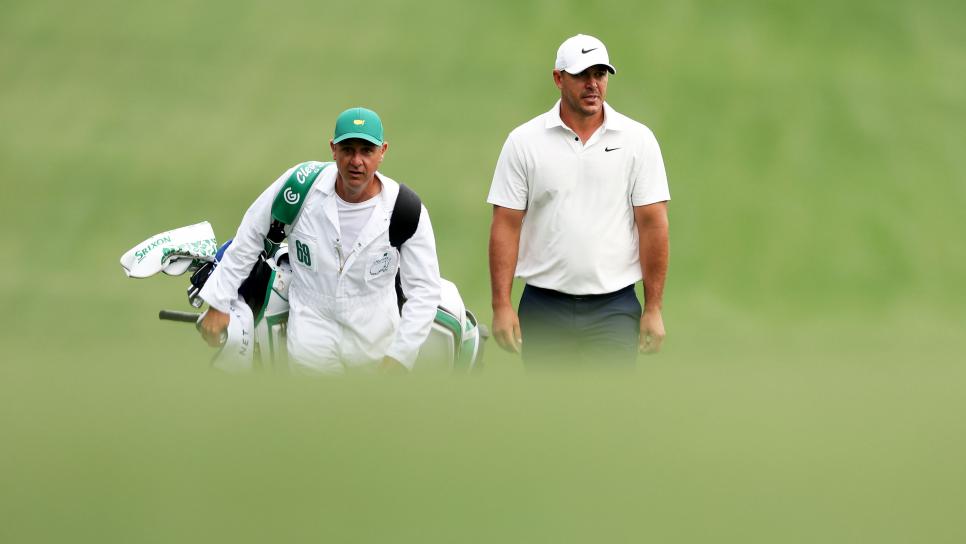
Christian Petersen
Koepka says that wasn’t the case here: “We looked at it when we got back in. [Gary Woodland] and [Gary Woodland’s caddie] had no idea what we were hitting; they didn’t even know—I know that fact because [Woodland] asked me what we hit walking off, when we were walking down.”
Had tournament officials ruled differently, Koepka would have gotten a two-stroke penalty for his caddie’s actions. And if Woodland had requested the information, he would have received a two-stroke penalty, too.
• • •
A cart ride nearly costs one pro a PGA Tour card
Wilson Furr, 24, was playing in the second round of the Lemon Suncoast Classic, a Korn Ferry event near Sarasota, Florida. Furr (below) and the two other players in his group started on the 10th hole and, after finishing 18 and about to make the trek over to the first hole, they walked through a tunnel under a grandstand where they noticed a volunteer sitting in the driver’s seat of an empty three-rowed golf cart. It was the same type of vehicle that took the players from the driving range to the 10th tee.
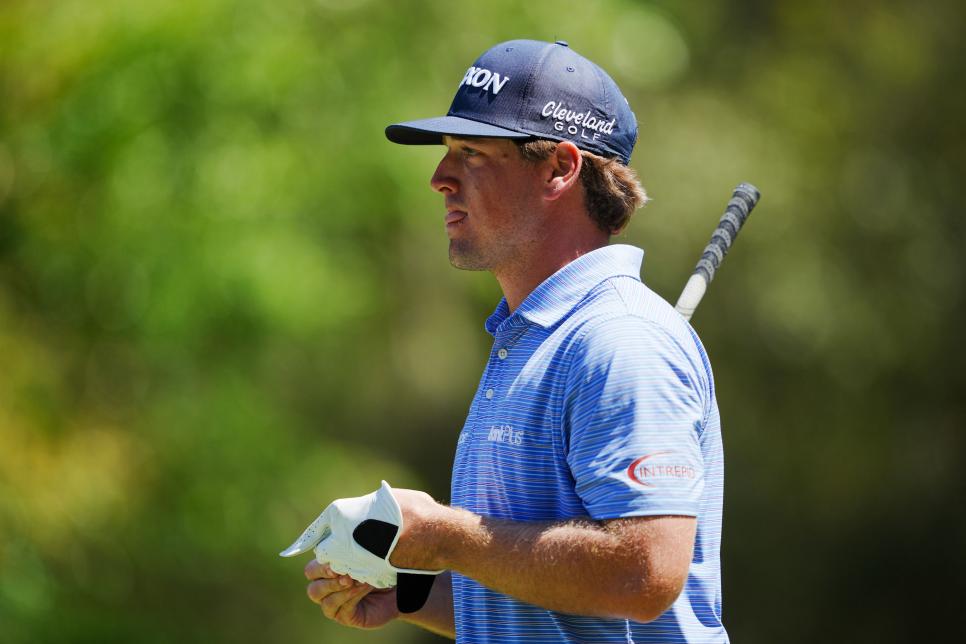
Andrew Wevers
One of the members of Furr’s group, Alejandro Tosti, asked the driver if he was giving rides over to the first hole. The driver said yes and shuttled them over. Unfortunately, a Model Local Rule was in place prohibiting players from getting a golf-cart ride during the round. The driver didn’t know any better, but this rule was posted and circulated among players before the tournament.
The end result was a two-shot penalty for all three members of the group. That penalty played a key role in Furr missing the cut and it bumped his status on the Korn Ferry Tour for part of the year. The good news is Furr rebounded and played well enough in the KFT Championship to earn a PGA Tour card.
• • •
Brooks Koepka takes (a lot of) relief from a fan village
Playing a LIV Golf event in Singapore, Brooks Koepka lost a tee shot into the trees on the par-4 15th at the Sentosa GC. Upon reaching his ball, Koepka noticed that although his ball was blocked from a conventional shot into the green, a fan village to his right was preventing him from taking an alternate route.
Employing a Model Local Rule commonly used in tournaments with spectators, Koepka argued he was entitled to free relief because the fan village was a temporary immovable obstruction (TIO), and it was blocking his shot into the green. The on-course reporter following Koepka was incredulous: “I didn’t think that was an option, to be honest with you,” Dom Boulet said. “He’s got to go through a couple of trees to take that option.”
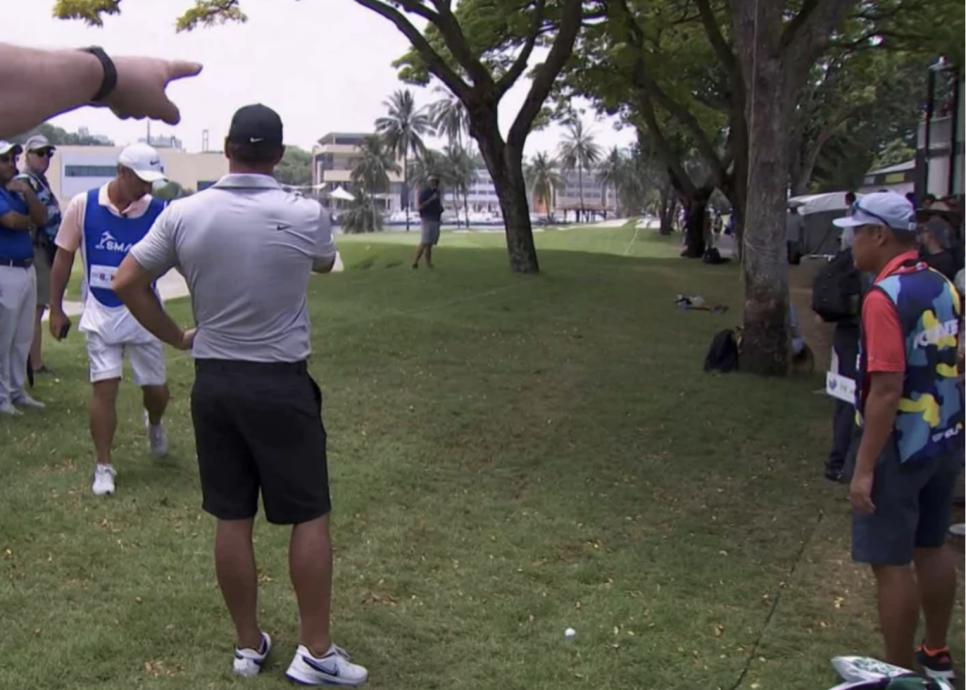
Koepka was granted relief, however, which permitted him to get a clean line to the 15th green. That clean line just happened to be in the fairway on the 16th hole, which was a considerable distance from where his ball came to rest. On the broadcast, David Feherty commented that Koepka was now “about 200 club-lengths from where he was.” Regardless, Koepka hit the green and made par.
• • •
Golfer shoots 62 in US Open qualifier, then DQ’s himself
Playing in a US Open local qualifier in May at Illini Country Club in Springfield, Illinois, Tommy Kuhl was having the round of his life. The senior at the University of Illinois shot a course-record 62 to easily capture medalist honors and advance to the final stage of qualifying. Then the hammer came down.

Craig Pessman/Illinois Athletics
After watching some of his Illini teammates also try to qualify, one mentioned to Kuhl how hard it was to putt on the course’s aerated greens. That’s when it dawned on Kuhl he might have made a huge mistake. Kuhl had repaired several aeration marks during his amazing round, and that is not permitted under Rule 13.1. The committee could have enacted a Model Local Rule to permit that type of repair, but that wasn’t the case and Kuhl was disqualified. You’re allowed to repair nearly every type of blemish on a putting green such as pitch marks, spike marks, scrapes, etc., but aeration marks are considered normal maintenance and must be left as is.
“I should have known better,” Kuhl said. “I should know that rule.”
• • •
NCAA D-III Championship round cancelled due to silly pin placement
Watching golfers try to hole out on the sixth hole during the third round of the NCAA’s Division III Women’s Golf Championship, you would have thought they were on camera being punked. Mission Inn and Resort’s El Campeon Course in Howey-in-the-Hills, Florida, was the site of one of the most outrageous pin placements in tournament-golf history.
On the 308-yard par 4, a hole was cut on a 5-percent slope on the right side of the green. Putts that missed the cup often finished back by the golfer who hit it, or worse, rolled off the green. Dozens of golfers tried their best to get the ball in the cup, but their efforts resulted in a compilation blooper video.
Round 3 of the NCAA D3 Women’s Golf Championship was canceled (with nearly 60% of the field finished) because of this hole location, which the NCAA deemed “unplayable.”
Story: https://t.co/lJdUMFYQDc pic.twitter.com/rrsZg2ySIS
— Brentley Romine (@BrentleyGC) May 12, 2023
Eventually, the NCAA deciding to wipe out the entire round from the competition as it deemed the hole location too severe – unplayable, actually. The majority of the 151-player field had already finished the hole when the decision was made to cut the national championship down to 54 holes, which was won by George Fox University.
• • •
Viktor Hovland’s ball gets eaten alive by a bunker lip at the PGA Championship 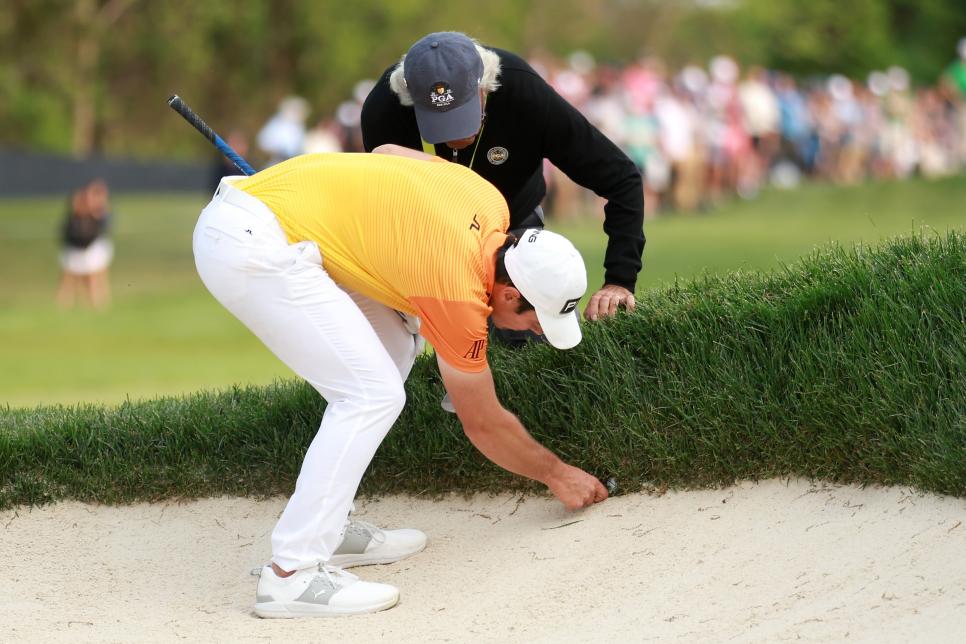
Warren Little
There are tough breaks in golf and then there’s what happened to Viktor Hovland in the final round of the PGA Championship. Playing the 16th hole at Oak Hill Country Club, one shot back of tournament leader Brooks Koepka, Hovland hit his tee shot into a fairway bunker with a high, grassy lip on the right side of the hole.
Facing a 172-yard approach shot from the sand, Hovland made a swing that produced a ball flight that was way too low to clear the lip. In fact, the ball embedded in the grassy lip just above the sand.
Viktor Hovland's second shot caught the lip of the bunker.
He made double bogey on 16. pic.twitter.com/mzE4SN6rRE
— PGA TOUR (@PGATOUR) May 21, 2023
Hovland got free relief for an embedded ball in the general area of the course (Rule 16.3), but the drop he was allowed to make put his ball in the thick grass just outside the bunker and he ended up making a double bogey and falling too far behind Koepka to catch him.
Ironically, Corey Conners suffered a very similar fate the preceding round, taking a double bogey and falling out of contention after rocketing a ball into the same grassy lip.
• • •
Phil Mickelson loses debate with rules officials, gets lucky to avoid a penalty
Phil Mickelson doesn’t like to lose an argument, but that’s how things shook out during the second round of the PGA Championship, and it might have been the best thing that could have happened to him. Mickelson had hit his drive into water off the tee down the right side of the par-4 sixth hole at Oak Hill Country Club. Mickelson proceeded to take a penalty drop only to be approached by a rules official who proceeded to inform Lefty that he had taken a bad drop.
A discussion ensued, with Mickelson asking the opinion of a second official, who agreed with the first. Mickelson believed he had a two club-length semicircle to take the drop, but under a change to the rules that went into effect early in 2023, call for him to keep the drop directly on the line the ball went into the penalty area.
“It’s OK,” the second rules official said. “You dropped it improperly, but you can just move it back.”
Mickelson then dropped for a second time, his ball now in the first cut of rough. He just missed hitting his third shot in the creek again, and eventually wound up making a double-bogey 6. Had he played from the incorrect spot, however, he would have had to add two more strokes to his score.
“Thanks for stopping me,” Mickelson said. “I appreciated it, that would have been, I appreciate your help.”
As it turned out, the two extra strokes would have caused him to miss the cut as he made it to the weekend on the number with a two-over 72 for the round and a five over for the championship. And that was the 100th time Mickelson had made a cut in his career in a major. Plus Mickelson tied the record for most cuts made at the PGA (27), joining Jack Nicklaus and Raymond Floyd.
• • •
Emiliano Grillo’s ball went for ride, and he could have hit it while it was moving
In one of the most nutso rules incidents in recent memory, Emiliano Grillo won the Charles Schwab Challenge at Colonial Country Club in Fort Worth in May despite watching his tee shot on the 72nd hole drift down an aqueduct alongside the fairway.
He went into the 18th with a two-shot lead and opted for a driver off the tee. His ball sailed right of the hole and went into a penalty area, an aqueduct only three inches or so deep. The canal sloped away from the green, so Grillo’s ball started slowly drifting back toward the tee box when it entered the water. The ball entered the penalty area roughly 187 yards from the hole, and that would have been the location where Grillo could have taken a one-stroke penalty and dropped per Rule 17.
Bizarre scenes on 18.
Leader Emiliano Grillo’s tee shot finds a water stream and takes five minutes to eventually come to a stop.
Grillo takes a penalty stroke and plays where the golf ball entered the stream @CSChallengeFW. pic.twitter.com/cc3XibhSwR
— PGA TOUR (@PGATOUR) May 28, 2023
However, there was another option. Under Rule 10.1d, you are allowed to make a stroke at a moving ball in temporary water or a penalty area without having to accept a one-stroke penalty. Grillo said after the round that he knew his options because it’s not the first time his ball found that aqueduct. But even if he wanted to play the moving ball, he waited too long this time to pull the trigger (there is a time limit before you’re considered to be unduly delaying play).
The ball ended up drifting about 140 yards before it stopped. Grillo fished it out and attempted to take a drop in the correct location where it first entered the aqueduct, but the ball rolled back in—twice. Since the adjacent cart path was outside the penalty area, Grillo decided to take his drop for his third shot on the concrete, which was considered an immovable obstruction (you’re allowed to play off an immovable obstruction or take free relief).
A wet and wild finish for Emiliano Grillo on 18.
Double bogey to drop into a tie for the lead. pic.twitter.com/oygu04Wa26
— PGA TOUR (@PGATOUR) May 28, 2023
After placing his ball on the path, Grillo hit his third shot, the ball landing short of the green. He eventually ended up making double bogey. The good news for him; he won in the ensuing playoff over Adam Schenk.
• • •
Rory McIlroy gets a bad ruling at the US Open
One week after Rory McIlroy finished second at the US Open in June at Los Angeles Country Club, the USGA admitted it had botched a free drop he was given during the final round. To recap, McIlroy’s third shot on the par-5 14th lodged into a sod wall above a fairway bunker. Applying Rule 16.3, rules official Courtney Myhrum told McIlroy he was entitled to free relief for an embedded ball (just like Viktor Hovland at the PGA Championship two months earlier). However, where he took that relief based on Myhrum’s instruction turned out to be incorrect.
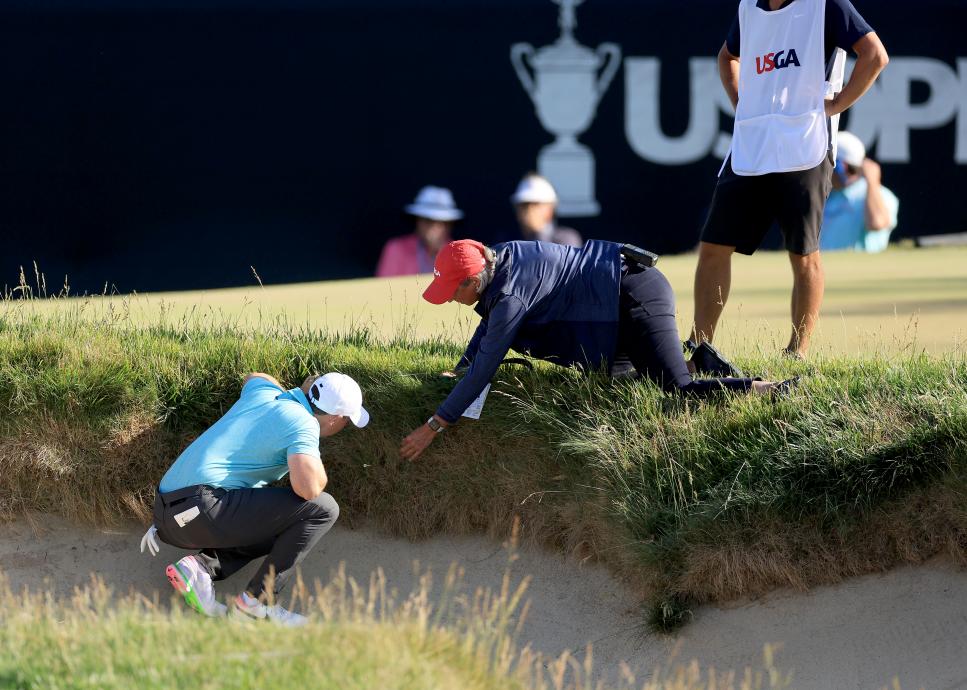
David Cannon
Instead of measuring his club-length from a spot immediately behind the ball, Myhrum allowed McIlroy to begin measuring at a spot to the side of the ball. This might seem a bit nitpicky (and it was), but that’s the correct procedure, according to the USGA’s Thomas Pagel. McIlroy still played his next shot from roughly the same location, on the shelf of the bunker, and wound up making his only bogey of the round at that hole. Pagel noted that McIlroy did not gain an advantage by playing from where he did, and he did so at the “discretion of the referee.”
It’s worth noting that free relief is given to an embedded ball in the general area of the course, but to be considered embedded, the ball has to be in its own pitch mark as a result of the previous stroke, and part of the ball has to be below the level of the ground.
• • •
Sam Burns tried his best to get free relief from bizarre lie
Somewhat similar to McIlroy’s situation during the final round of the U.S. Open, when his ball embedded into the sod wall above the bunker, Sam Burns got himself in a bit of trouble during the third round of the Genesis Scottish Open—and couldn’t talk his way out of it.
Burns hit into a bunker off the tee on the 10th hole of the Renaissance Club. When trying to escape it with his second shot, his ball didn’t clear the lip and hung up on the grooved sod above the sand.
How has @Samburns66 ball stayed there…? 🤯#GenesisScottishOpen | #RolexSeries pic.twitter.com/oVclPek8nG
— DP World Tour (@DPWorldTour) July 15, 2023
Burns immediately called for a rules official and tried to argue he should get free relief from the unusual lie. Burns was adamant, arguing for roughly 10 minutes. There was even some discussion among officials about him playing two balls until they could make a proper ruling after the round. But in the end, the request was denied, and Burns had to play from the lip. His third shot caromed off the sod and fell back into the bunker, and he ended up taking a triple-bogey 8 on the hole.
• • •
Lydia Ko’s seven(!)-shot penalty
When things get too soggy at a tournament, officials often allow golfers to move their ball or lift, clean and replace it to counter the soft, muddy conditions. During the final round of the Dana Open, the LPGA had granted preferred lies for the first and 10th holes at Highland Meadows Golf Club in Sylvania, Ohio.
Lydia Ko mistakenly breached Rule 14.7a by taking preferred lies on the third, seventh and ninth holes, which means she played from the wrong place (each infraction comes with a two-shot penalty). And on the 11th, she lifted her ball only to call for a ruling. It was then she found out that they weren’t playing lift, clean and place on the entire course, so she put her ball back in the original spot and took a seventh penalty stroke of the round for improperly picking up her ball.

NurPhoto
Interestingly, Ko played that tournament without her regular caddie, David Jones. You could argue Jones might have been seasoned enough to prevent Ko from making those mistakes. She wound up shooting a 78 that day.
• • •
Pro admits to cheating at a PGA Tour Canada tournament
In perhaps the year’s most cringy rules moment, pro golfer Justin Doeden admitted that he had cheated in the PGA Tour Canada’s Commissionaires Ottawa Open. Doeden was being investigated after another player alerted tournament officials that he might have turned in a score lower than he actually shot.
This took place in July at the Eagle Creek Golf Club in Ontario, Canada. After shooting a first-round 68, Doeden (below) signed for a 71 in the second round. His three-under-par tournament score raised the suspicion of one of his playing partners, who thought Doeden had shot a 73 in the second round, including a double-bogey 7 on the final hole.

Icon Sportswire
When Doeden’s second-round card was inspected, a 7 had been erased and replaced with a 5 on the final hole. The walking scorer and his playing partners confirmed Doeden had hit his second shot in the water on the par-5 hole and eventually tapped in for a 7. The score change was noteworthy, as making a 5 instead of a 7 on the final hole would have allowed Doeden to make the tournament’s cut on the number. When asked about the score discrepancy after the round, Doeden told PGA Tour Canada officials he had made a 5 on the hole.
Eventually, he withdrew and admitted to the cheating.
“I am here to confess of the biggest mistake I have made in my life to date. I cheated in golf,” he said. This is not who I am. I let my sponsors down. I let my competitors down. I let my family down. I let myself down. I pray for your forgiveness. John 1:9.”
Doeden now plays on the PGA Tour Latinoamerica.
• • •
Carlotta Ciganda DQ’d after refusing to accept slow-play penalty
After shooting a one-over-par 72 in the second round of the Amudi Evian Championship in France in late July, Carlotta Ciganda refused to accept the slow-play penalty she received on the ninth hole. Instead, she turned in a scorecard without the two additional strokes she was supposed to add—thus forcing the LPGA tour to disqualify her for signing an incorrect scorecard.

Stuart Franklin
The 33-year-old from Spain first received a warning on the seventh hole, along with the other players in her group, Anna Nordqvist and Celine Herbin, after the threesome fell far behind the players in front of them. Ciganda’s group was then timed on the eighth hole and eventually penalized on the ninth for not catching up. The penalty is two strokes, according to the LPGA’s policy.
After the round, Ciganda appealed the penalty, but it was upheld, and she walked out of the scorer’s tent without signing for her actual (higher) score, which is grounds for immediate disqualification under Rule 3.3b(3). It should be noted that had she accepted the penalty, she likely would have missed the cut anyway. She was six over par for the two rounds.
• • •
LET pro qualifies for a playoff, decapitates her driver on the way to the tee
The KPMG Women’s Irish Open ended in dramatic (and bizarre) fashion this past September. After making a birdie on the final hole of regulation to secure a spot in a playoff with Smilla Tarning Sonderby and Lisa Pettersson, former European Solheim Cup team member Anne Van Dam hopped into a golf cart to be shuttled to the tee of the first playoff hole.
As the cart drove under a gallery rope held up by Van Dam, she let go of the rope a bit too soon and it snagged her driver, pulling her entire golf bag off the cart. She jumped out to retrieve the bag only to find the head of her driver had snapped off.
Wow how unfortunate is this and I’m lost for words @Annevandam driver snapped heading back to the 18th @GolfDromoland for playoff @LETgolf 😳 @KPMG pic.twitter.com/CR2klQY2JW
— David Foley PGA (@davidjfoley) September 3, 2023
Rule 4.1 allows for a player to replace or fix any damaged club except for cases of anger or abuse. Certainly, busting a driver with a gallery rope does not fall under anger or abuse, so Van Dam could have replaced her driver had she another in her locker that could have been fetched. But there was no time, and no spare driver.
Although she went with her 3-wood off the tee of the par-5 playoff hole, she still made a birdie. Unfortunately, Sonderby eagled to win the event.
• • •
Australia’s former US Amateur champ misses tee time, DQ’s from Korn Ferry finals 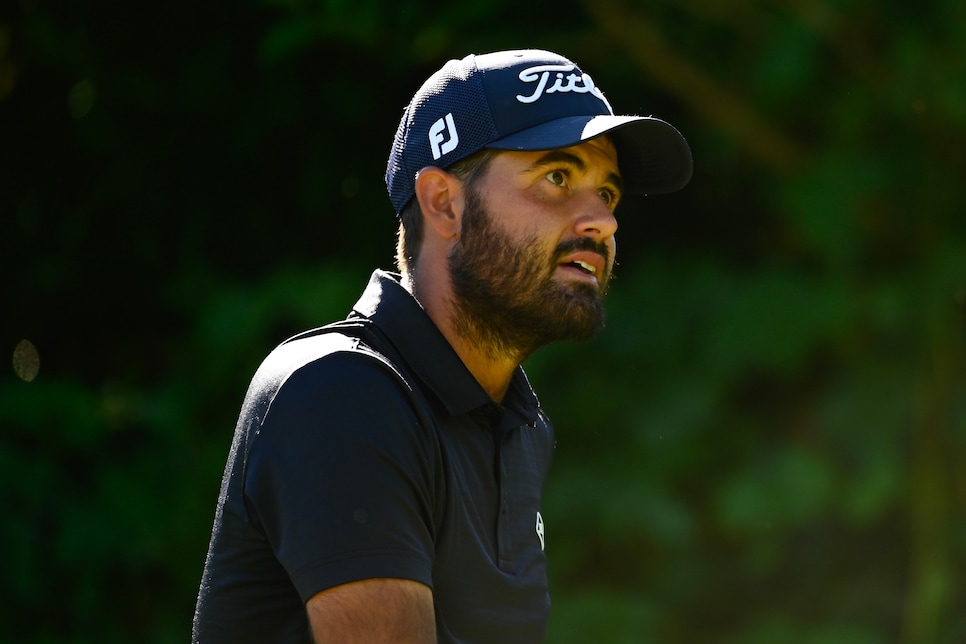
Alex Goodlett
From the “you had one job” department, former US Amateur champ Curtis Luck was disqualified from one of the Korn Ferry Tour’s most important tournaments in September, because he was on the driving range when his group teed off.
“I just flat-out misread my tee time,” said Luck, who also had a replacement caddie on the bag that week. “I thought I was off at 7:55 a.m. and I was just on the range finishing my warm-up. I actually started walking to the tee at 7:46 a.m.”
With a chance to earn a PGA Tour card, Luck was about to play in the Albertsons Boise Open, a Korn Ferry Tour Finals event. Had he arrived at the first tee of Hillcrest Country Club even five minutes late, he could have played after taking a two-stroke penalty. Alas, he didn’t make it there in time and was DQ’d.
Luck, who won the 2016 U.S. Amateur and played one full season on the PGA Tour in 2018-’19, still has status on the KFT heading into 2024.
• • •
Gut-wrenching mistake costs a Korn Ferry player a spot on the PGA Tour
Although he bogeyed the final hole of the Korn Ferry Tour Championship at Victoria National Golf Club in Indiana, Shad Tuten was still in position to earn his very first PGA Tour card, as the top 30 in the field at that event graduate to the big tour each year. The 31-year-old from Augusta, Ga., who had never played in a PGA Tour event, was projected to hold on to the final spot on the season-ending points list in part because of a birdie he made on the 15th hole.
Or so he thought.
Before signing his scorecard, Tuten was informed that while playing the 15th, he did not correctly follow the procedure outlined in Rule 14.2e, which involves how to replace a lifted ball that won’t stay in its original spot. He replaced his ball in the wrong spot (we’ll explain what happened in a moment) and was given a two-stroke penalty for playing from the wrong place (Rule 14.7). Those two shots bumped him out of the top 30 and essentially cost him his PGA Tour card.
So what happened?

Mike Mulholland
Tuten drove it in the rough on 15, hacked back into the fairway, and had roughly 120 yards left into the green for his third. With a lift-clean-and-place rule in effect because of wet conditions, Tuten picked up his ball. But when he tried to replace it, it would stay put in its original location. After trying once, Tuten moved it a few inches to the right and played on.
What Tuten should have done is tried a second time to replace the ball in its original spot. If it had moved again, then he could have found the nearest spot where it would not move and place it there.
Although he had made a 14-foot birdie putt on that hole, his score became a bogey and he dropped to 32nd on the KFT qualifying list. It was that kind of year.



